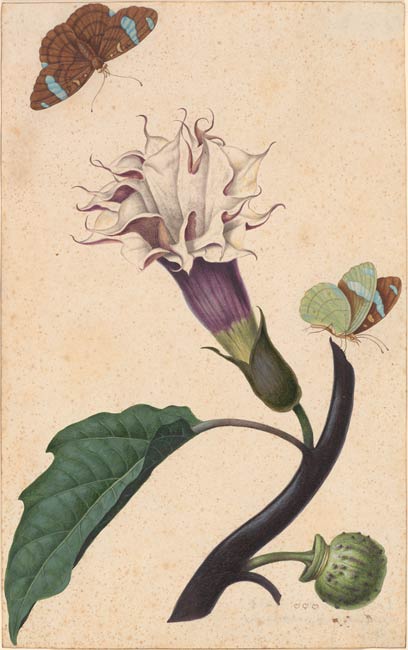
Unusually, this drawing was executed in two distinct stages. The night-blooming Datura, a flower that was not native to the Dutch Republic, was drawn by De Heer in 1679. The artist seems to have marveled at the complex anatomy and subtle coloration of the plant, which in this drawing achieves an almost sculptural quality. The two butterflies were added by Merian sixteen years later. Although they give the impression of playfully fluttering around the plant, the insects were rendered in a scientific manner, allowing both their inner and outer wings to be easily observed. The butterflies have been described as South-American morphos; the exact species cannot be identified. The inscription on the verso indicates that the addition of the butterflies was commissioned by Agnes Block (1629-1704), one of Merian's great patrons. Although Block's inscription does not mention De Heer's involvement, entry 6 in volume 28 of the inventory of Valerius Röver, who purchased Block's collection from her heirs, specifies his contribution: "6. datura contaneri flos et fructus waar bij 2 Capellen van van Juf Merian de bloem van W: de Heer Ao. 1679 geschilderd." For a discussion of Merian's work for Block, including her "collaborations" with De Heer, see Sam Segal, "Merian as a Flower Painter," in Kurt Wettengl, ed., Maria Sibylla Merian (1647-1717): Artist and Naturalist (Frankfurt am Main, 1998), esp. pp. 79-82.
Inscribed at lower right, in pen and brown inl, miscellaneous heart-shaped marks; on verso at lower left, in the hand of Agneta Blok, datura Contareni. flos et fructus. [symbol] / 2 capelen by ju.r m:s:merian. 1695 / N 628; at lower center, in black chalk, a paraph [?]; at bottom center, in graphite, 9001 [?].
Heer, Guilliam de, ca. 1638-1681.
Merian, Maria Sibylla, 1647-1717.
Block, Agnes, 1629-1704, former owner.
Röver, Valerius, 1686-1739, former owner.
Ryskamp, Charles, former owner.
William Griswold et. al., The World Observed: Five Centuries of Drawings from the Collection of Charles Ryskamp. New York, 2001, no. 26.
